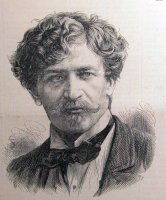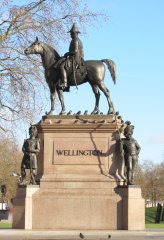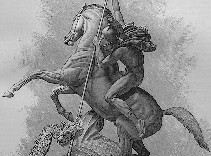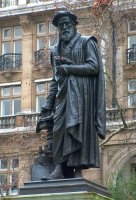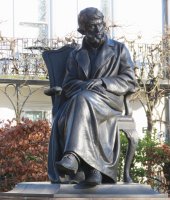Sir Joseph Edgar Boehm Bt (1834-1890)
J. E. Boehm was one of the foremost Victorian portrait sculptors, with several public statues to his name, including the equestrian statue of Wellington at Hyde Park Corner.
Joseph Edgar Boehm was Hungarian by descent, but born in Vienna and educated in that city. His father was Director of the Imperial Mint and possessor of a huge collection of fine art from the times of ancient Egypt onwards. With these surroundings, it is unsurprising that the young Boehm was inspired to become an artist, although there was some pressure to follow his father's lucrative profession. He was given a general education, first in Vienna, then in England, where he spent much time studying the drawings of the old masters and sketching from the Elgin Marbles in the British Museum. His father had a job arranged for him back at the Austrian Mint, but Boehm had by this time decided to be a sculptor, and went to Paris.
Wellington Statue, Hyde Park Corner.
As young as age 22, Boehm won the Imperial Prize at Vienna in 1856, the first of various honours. He settled in England in 1862, and was naturalised in 1865. He was elected Associate of the Royal Academy in 1878, and full Royal Academician in 1882.
Boehm believed in making contemporary sculpture, not harking too much back to the past, and he disapproved of sculptors 'trying to be ancient Greeks':
"It is in vain to complain of the paucity of inspiring subjects in our age, of our ugly costume and the dearth of suitable figures for sculpture. You may regard objects and compose like Homer, but you may not inanely copy from the antique. Do not return from Rome with some more bad nymphs, another Venus or another Cupid. Try to use the much-abused dress. Treat a coat-sleeve, a woman's gown, con amore, ennoble it by art, and it will be a pleasing object in the sight of those whose praise is worth having."
To be fair, Boehm wrote this in reaction to the continental and especially Italian school of overdone gesticulation, and might well have reacted differently to late Victorian sculpture. After all, there can never be enough good Venuses and nymphs.
St George and the Dragon.
Boehm was particularly a portraitist, and said that the first and most necessary talent of good portraiture was 'an instinctive perception of character'.
There are various statues by Boehm in central London. In St Paul's is his well-known General Gordon, and in Westminster Abbey he has Disraeli and Dean Stanley. The large equestrian Wellington, with four soldiers around the base, is at Hyde Park Corner near the Marble Arch; it is not considered one of his better pieces. And at the end of Fleet Street, his are the statues of Queen Victoria and Prince Edward on the Temple Bar monument. His too is the Tyndale in the Victoria Embankment Gardens, his Carlyle is in Chelsea Embankment Gardens, and his Lord Lawrence and Burgoyne are at Waterloo Place. His Charles Darwin statue is in the Natural History Museum, and a representative series of portrait busts by Boehm are at the National Portrait Gallery.
Outside of London, we should mention Queen Victoria statues by Boehm for Windsor and Exeter: he was a favourite of the Queen, and executed a large number of Royal portrait statues, as well as her own portrait for the coinage of the time and several medals. Also to note are Boehm's statue of M. T. Bass in Derby and the the Bunyan Memorial in Bedford, and two Francis Drake statues in Plymouth and in Tavistock, Devon. And there are several statues by him in Scotland, including John Elder in the eponymous park in Glasgow, and the Duke of Buccleuch in Edinburgh. Finally, Boehm has several impressive memorial pieces: the Bishop Dunscombe monument in York Minster, Emperor Frederick in Windsor, and Archibald Tait in Canterbury. As well as such grander full length figure memorials, Boehm has the occasional smaller piece, for example the General De Salis monument in Harlington Church, with a portrait bust.
Boehm was made Baronet in 1889, but died in the following year, having not even reached his 60th birthday, and was buried in St Paul's Cathedral.
Tyndale, Carlyle.
I find Boehm's portrait sculpture very characterful, sympathetic, in line with his quote above. Of his London statues, perhaps the best are the Carlyle, elderly, rather thin, wrapped in his long coat, and Tyndale on the Victoria Embankment, also with much made of the light and shade cast by the drapery. His ideal works were rather few - an Eurydice, Victorian in physique, Greek in pose, and rather full in the thighs; a later Galatea, the odd angels and cherubs and nymphs, and a work intriguingly entitled 'Group of Horsemen, carrying off a Lady' which I have not seen even in reproduction.
Though Boehm's work was solidly Victorian, several important younger artists of the group later known as the New Sculptors studied for a time in his studio, notably Alfred Drury, Alfred Gilbert, George Frampton and Edouard Lanteri.
Visitors to this page since 13 Mar 2014: 8,715
